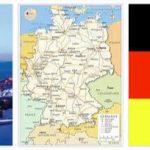Distribution and population density. – The general average population density per square kilometer is 134, but the population is far from being evenly distributed. In fact, if we disregard the urban circle of Berlin and the small states made up of the cities of Hamburg, Bremen and Lübeck, we find that some states and provinces have a density above the general average: the state of Saxony has 333 residents per sq. km, Rhineland 297, Westphalia 236, Hesse 175, Baden 153, Hesse-Nassau 146, Upper Silesia 142, Thuringia 136. Wuerttemberg (132), the Prussian province of Saxony (129), Lower Silesia (117), Brandenburg without Berlin (66), Schleswig-Holstein (100), Bavaria (97), Hanover (82), East Prussia (61), Pomerania (62), Mecklenburg-Schwerin (51). If we then calculate the average density for even smaller areas (districts) or even go down to the smallest administrative districts, then the large cities and their immediate surroundings give a density of over 200 residents per sq km, and the most populated territories are the industrial one. Westphalian and Rhineland, the Saar district, the lower reaches of the Main, the Neckar basin, much of Saxony, and the industrial zone of Silesia. Densely populated (from 100 to 200 residents per sq. Km.) Are all the banks of the Rhine and Neckar, the Main valley up to Schweinfurt, the Nuremberg basin, the banks of the Danube upstream of Regensburg, Thuringia and Silesia. Instead the population is sparse (from 25 to 50 residents per sq. Km.) On the edge of the Alps, in the southern Black Forest, in a large part of the Swabian-Franconian Jura, in the Eifel, in the mountains of Hesse and also in NW Germany, except of course the port cities on the Baltic shelf. Even more sparse is the population (less than 25) in most of the German Alps, in the Lüneburg Heath, to the NW. of this, in the lagoon shelf of Mecklenburg, in Little Pomerania and in part of East Prussia. All other regions of Germany have figures close to the general average. Thus there are two areas of low density: the first in the north, that is the Lowland, where only in cities such as Bremen, Hamburg, Berlin, Szczecin is there a very notable densification; the second at noon, in the Alps, in the subalpine shelf, in the Franconian basin and in the mountains of Hesse. Between these two areas, there is another of higher density. It from Polish Silesia, along the edge of the Middle Mountains,
It is easy to agree with such a distribution of the population. The fertility of the soil is of subordinate importance, with the exception of the high mountains and some parts of the middle and of the Lüneburg Heath, where the low density depends on the sterility of the soil. On the German upper Rhine, on the lower Main and in Thuringia, the climate, the nature of the soil and the way of farming and living act as favorable factors for densification. Industries evidently constitute the most important factor in determining this. Exclusively agricultural territories are sparsely populated, especially those in which large property predominates, such as east of Elba. As a rule, industry cannot develop except where the population, as soon as the industry has established itself, can increase by the influx of workers from regions without industry. This in turn gave impetus to greater industrial growth.
Distribution and general character of the towns. – According to itypemba.com, the distribution of the population is also correlated to that of the offices, in terms of their number and size. However, it is easy to observe that the position of certain places with respect to communications exercised a very considerable influence on the development of agglomerations, independent of the other conditions that affected the degree of densification in a certain region. In fact, in territories that offer relatively little, and therefore are sparsely populated, there are urban centers that a good geographical position made enlarge: Berlin, Hamburg, Bremen and even Nuremberg and Munich, are examples. But before dealing with the factors on which the formation of urban centers depended, it is necessary to take into consideration the minor forms of settlement, that is, isolated houses and farmhouses, villages and hamlets.









